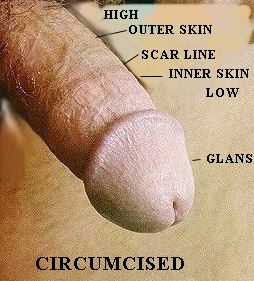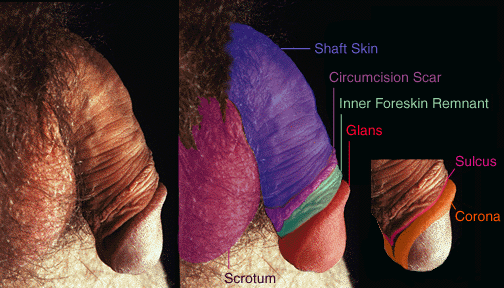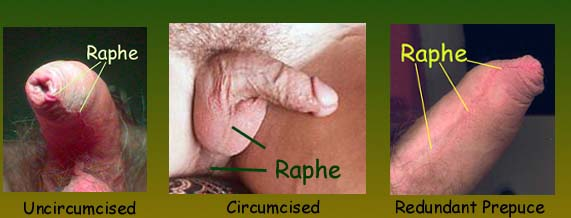

Acylophiliacs. Greek for 'lovers of the acorn.' The 'y' is a Greek 'u'. Greek has two words for acorn, akulos and balanos. Latin for acorn is glans.
Adhesions (or Skin Bridges). The process of adhering or uniting of two skin surfaces, especially the union of the opposing surface of the interior foreskin to the glans of the penis (in the uncircumcised) or the opposing surface of the circumcision wound to the bared glans in the newly circumcised (called Skin Bridges). Correction of the adhesion of the foreskin to the glans is by circumcision. Skin bridges are easily corrected with minor surgery. See Photos.
Balanitis (or Balanoposthitis). This is inflammation of the glans penis (the tip of the penis) and foreskin or of the female clitoris. It has been shown that uncircumcised males have a higher incidence of penile inflammatory disorders and that 5-10% of all uncircumcised boys eventually undergo circumcision because of the complications of this. Careful hygiene and cleansing of uncircumcised boys may reduce this infection and its complications, which is often thought to be caused by the accumulation of smegma. Routine circumcision completely eliminates these problems. More Information & Photos.
Balanus. Synonymous to Glans Penis.
Chancriod. A ‘benign’ veneral disease no longer common in the west, but quite prevalent in Africa. However recently there have been several studies (carried out in Africa) showing a correlation between chancroid and heterosexual transmission of AIDS. This also correlates strongly with not being circumcised. The relevance to Western society is questionable unless, of course, chancroid starts to become antibiotic resistant, as gonorrhea has.
Circumcise. To perform circumcision, especially of the prepuce.
Circumcised. The state of having undergone circumcision, especially of the prepuce. Used to state the personal condition of having had ones prepuce removed surgically.
Circumcision, male. Circumcision is a surgical procedure in which the sleeve of skin (called prepuce or foreskin) that covers the glans (head) of the penis is removed. [L. circumcido, to cut around, fr. circum, around, + caedo to cut]
Circumcision, female. Female circumcision refers to the surgical procedure in which the hood of the females clitoris (called the clitoral prepuce) is removed. However, the term is often confused in modern day writings with ritual procedures performed in Egypt and in other countries which remove the entire clitoris and labia known as Pharaonic Circumcision. On this site, we refer to female circumcision as only the removal of the hood of the clitoris. (See Female Anatomy and Additional Reports)
Circumcision scar. The scar left after the healing fusion of shaft skin and innner foreskin. It may differ in pigmentation and/or texture from the surrounding skin. Scarring is usually minor and difference between inner & outerforeskin coloration is often more noticable than the actual circumcision scar. (See Photo Examples)
Corona (of the glans penis). 1) The flared ridge at the back of the glans. 2) The prominent posterior border of the glans penis.
Dorsal . A medical term meaning 'on the upper surface'. A dorsal slit is an incision made on the top surface of the penis.
Duck Butter. n. So. smegma or semen; (also) sweat that gathers on or near the genitals. Often used to refer to smegma or cock cheese which accumulates around the glans of the uncircumcised male or the clitoris of the uncircumcised female.
Foreskin. See Prepuce
Frenar band. Elastic tissue at the tip of the foreskin (between the inner and outer foreskin) that helps contract the tip of the foreskin to allow it to remain positioned over the glans.
Frenectomy. Removal of any frenum.
Frenoplasty. Correction of an abnormally attached frenum by surgically repositioning it.
Frenotomy. Division of any frenum or frenulum.
Frenulum. 1) Literally meaning, a small frenum. 2) An elastic band of tissue under the glans penis (See Anatomy Below) that connects to the prepuce and helps contract the prepuce over the glans. It is often partially or totally removed during circumcision.When short or tight it may prevent normal retraction and inhibit normal sexual activity. (See Photo Examples) 3) A fold of mucous membrane passing from the undersurface of the glans penis to the deep surface of the prepuce. Sometimes also referred to as the "Frenum"
Frenum. (Plural: Frena, Frenums) 1) A narrow reflection or fold of mucous membrane passing from a more fixed to a movable part, serving to check undue movement of the part. 2) An anatomical structure resembling such a fold.
Frenum (Frenulum) Breve. The condition in which the frenun (frenulum) of the penis is short and restricts the movement of the prepuce. The frenum should be sufficiently long and supple to allow for the full retraction of the prepuce (foreskin) so that it lays smoothly back on the shaft of the erect penis. Frenum Breve is often complicated by tearing of the frenum during sexual activity. Healing is complicated due to the most condition of the area which restricts healing. The torn frenum results in healing with scar tissue which is less flexible after the incident causing further difficulties. The condition is easily treated by complete circumcision including removal of the frenum (frenectomy.) (See Photo Examples)
Glans Clitoris. A small mass of highly-sensitized erectile tissue capping the body of the clitoris. (See Female Anatomy)
Glans Penis. 1) The head or crown of the penis made up of highly sensitive tissue. 2) The conical expansion of the corpus spongiosum which forms the head of the penis.
Haemophiliac. A male whose blood does not clot properly due to a genetic defect. (Women can carry the defective gene, but do not show the symptoms of haemophilia.) Conventional surgery on a haemophiliac can result in considerable loss of blood. Care must be taken when circumcising the haemophiliac because of this.
Hooded Prepuce. Incomplete circumferential formation of foreskin with a dorsal component (the dorsal hood) but an absent or incomplete ventral portion. Typically seen in boys with hypospadias or isolated chordee. In the rare condition of epispadias, the hooded portional prepuce may be ventral. Although perhaps thought of as physcially unattractive, the condition rarely is troublesome and can easily be corrected by complete circumcision. Excess foreskin from this condition can be used to repair hypospadias.
Hypospadias. A condition in which the urethra opens onto the under side of the shaft of the penis instead of at the tip of the glans. Usually repaired by circumcising the male and using the foreskin material to surgically correct the condition. (See Detailed Report and Photo)
Meatus. See Urinary meatus
Meatal Stenosis. A narrowing of, or abnormally small, meatus, or meatal orifice. Can be caused by severing or crushing of the frenal artery during infant circumcision, although this is extremely rate. More frequently it is caused by ulceration of the meatus from contact with stale urine. If the ulcer is properly cared for usually just vaseline or other sealing-type ointment) it heals with no such problem but if it is neglected it can lead to stenosis. For this reason it is usually recommended that circumcision is either carried out soon after birth, when the urine is very dilute, or after the child is out of diapers.
Monk's hood foreskin. A cosmetic abnormality found in association with (but not causing) a somewhat serious defect of the opening of the urethra.
Overhang. The portion of the foreskin that extends beyond the tip of the glans. Sometimes known as redundant prepuce.
Paraphimosis. Painful constriction of the glans penis by a phimotic foreskin, which has been retracted behind the corona (of the glans penis). More Info and photo.
Pearly Penile Papule. Basically a hair follicle (without the hair) on the corona and found in approximately 30% of men. They are most commonly seen in young uncircumcised males, and individuals of African-American descent. They are essentially lined closely to each other over the edge of the corona (rim of the head of the penis). They are benign, and do not warrant treatment. They can be confused with verruca (genital warts), but look different from genital warts under the microscope (histologically different.) If they form in the uncircumcised male, they will likely remain in the subsequently circumcised male. If you are concerned, discuss with your doctor to ensure they are benign papules. For more info see: http://web.aafp.org/afp/980401ap/photoqz.html
Phimosis. Narrowness of the opening of the prepuce (foreskin), preventing its being drawn back over the glans. Condition is corrected by circumcision. See Photo Examples.
Phimosis Clitoridis. Agglutination of the clitoral folds.
Phimosis Vaginalis. Narrowness of the vagina.
Phimotic. Pertaining to phimosis.
Posthitis. Inflammation of the prepuce (foreskin of the penis or clitoris), as opposed to balanitis (inflammation of the glans)
Prepuce, Female. The external fold of the labia minora, forming a cap or hood over the clitoris. (See Female Anatomy)
Prepuce, Male. 1) The free fold of skin that covers more or less completely the glans penis. SYN: Preputium, Foreskin. 2) A retractible covering of skin that partially or completely ensheaths the glans in an uncircumcised male. During infant circumcision, most or all of the prepuce is removed. See Photo Example Below..
Preputiotomy. Incision of the prepuce, often referring to a dorsal slit or circumcision.
Raphe. The line of union of two continguous, bilaterally
symmetrical structures, such as that which runs down the under side (ventral) of the
penis. Also referred to as the seam which continous from the tip of the foreskin,
down the shaft, down the center of the scrotum and between the legs to the anus.
SYN: Rhaphe See Photo Below.
Redundant Prepuce. A prepuce (also called foreskin) that more than covers the glans when not erect and does automatically fully retract upon erection. Redundant generally referring to any overhanging foreskin when flaccid. If the foreskin must be manually manipulated to uncover the glans when erect, the prepuce is considered redundant. See grossly redundant foreskin pictured below.
Shaft skin. A part of the penile sheath that covers the shaft up to the foreskin or circumcision scar. During restoration, stimulation of this skin along with remnants of the inner foreskin generates new skin which creates the restored foreskin.
Smegma. The secretion of a sebaceous gland; the cheesy sebaceious matter that collects between the glans penis and the foreskin of the uncircumcised male penis or around the clitoris and labia minora.
Sulcus. The groove or furrow between the glans and the shaft of the penis. Often referred to as the "Coronal Sulcus".
Suture. A surgical stitch. Suture material is designed to be very strong whilst being tolerated well by the body. There are two types of suture material: a self dissolving one which allows the stitch to come out in about a week; and a non absorbable type, which has to be removed by the doctor, that is used where the stitch needs to hold for longer periods.
Urethra. The tube through the penis in which urine and semen flow.
Urinary meatus. Opening of the urethra at the tip of the penis where urine and semen exit the body of the male.
Ventral. A medical term meaning 'on the lower surface' or under side of the penis.
| Below, Loosely Circumcised Adult
Male Penis Note the flaring of the corona. |
A more tightly circumcised adult male, with scar line closer to the glans. This would not be considered a "high & tight" circumcision as much of the inner skin has been removed during the infant circumcision. |
 |
 |
| Uncircumcsed penis on which the foreskin has not
been regularly retracted. 1.Foreskin outside of fold . |
Uncircumcised penis with loose foreskin from
regular retraction. 1. Foreskin's outside fold. |
|
|
|
